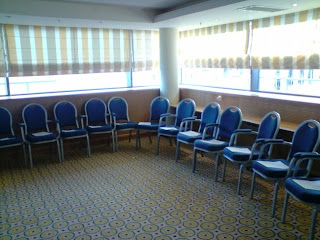Addiction
This is my technical blog, so I'll try to avoid getting too theological--but when I'm talking about what's closest to my heart, my true passion, it really does border on incoherence, spirituality, and insanity. That's probably as it should be, because it's our creative minds that see what's beyond our current perception of the universe. Without this borderline insanity, how would we be able to change the
is to the
could be? So please bear with me, and leave comments to help me see where my ramblings aren't clear.
Recently I made the difficult decision to return (with
my family) to my home in Philadelphia, after a 2-year adventure working in France. So, I've got big changes ahead--an international move and a new job. It's making me nostalgic, question my values, and reflect on what I've done. An essay by Paul Graham recently triggered even more reflection on my values: he talked about
Addiction. It really made me wonder whether I'm addicted to anything. The most likely candidate for me is the internet--but as I read from
Wikipedia:
The American Society of Addiction Medicine has this definition for Addiction: Addiction is a primary, chronic disease of brain reward, motivation, memory and related circuitry. Dysfunction in these circuits leads to characteristic biological, psychological, social and spiritual manifestations. This is reflected in the individual pursuing reward and/or relief by substance use and other behaviors. Addiction is characterized by impairment in behavioral control, craving, inability to consistently abstain, and diminished recognition of significant problems with one’s behaviors and interpersonal relationships. Like other chronic diseases, addiction involves cycles of relapse and remission. Without treatment or engagement in recovery activities, addiction is progressive and can result in disability or premature death.
Furthermore, addicts often are in denial--saying they choose, and like, the activity, to the extent that even when
something catastrophic happens they still insist they want it--but in reality they have no control. I find this definition problematic, because if clinicians can't diagnose addiction until something bad happens, it doesn't do us a lot of good in preventing these accidents.
Totems
So if addiction is the point at which a person can no longer heal oneself, and as Graham argues, we live in an environment that is getting more and more addictive, we need warning signs that work better than what we had in the past. He says that traditional, cultural, and social means for controlling addictive behavior are insufficient. For me, this is where Totems come in.
A Totem, in pre-historic times, was an animal with a spiritual connection to an individual. When that person was in trouble, the totem often showed up to help. Many cultures have used totems or icons of human form in various ways, leaving traces behind in the form of statues, idols, and carvings in temples, churches, roadways, and homes. Imagine traveling by foot for hours, coming around a corner and seeing a huge statue or relic like this, pictured right. It is inspiring, centering, and powerful. Even today many people use descendants of totems in the form of physical charms, to keep them centered. Take, for example,
Jerry Weinberg's consultant's kit--a box full of simple tools to remind him what to do when he has a problem.
As you may have noticed, though, the prevailing use of totems has evolved from the mystical to the symbolic. Consider how in ancient times people considered that the animals would come to us, then there were statues that happened to be along our route, and now there are charms we bring with us or place lovingly at an alter in our homes or places of worship. All are powerful, but there's something especially magical about the kind that show up before we know we need them, instead of when we turn to them. That kind of magic, I believe, is real, and can still be integrated into our lives today. It may be easier to explain this as the subconscious telling us to notice when something isn't right. Or if you're inclined to have fun with the mystical explanation--let me tell you I actually have a totem. I didn't pick it--but sometimes when things are out of balance in my life, I start seeing spiders. It's scary to admit it--I think it's a bit crazy even--but I'll be getting ready for work one morning, and there will be a spider in the shower. Then there will be one at the badge swipe at the front door of my office. Then one will drop down from the ceiling over my desk. Of course it could be chance--but when this happens all in one day--I get a bit freaked out. Don't get me wrong--I love the beauty of spider webs, the way they trap nuisance bugs, the metaphor of web-weaving and the internet--but I am also irrationally scared of spider bites. Or maybe I could say I have a healthy respect for spiders. This makes them a great totem for me. Maybe there's nothing supernatural going on here--maybe a neurologist could explain these sightings as a desperate attempt of my subconscious mind to be creative when I'm overly focussed on a project--and maybe that is why I notice spiders more when my life is out of balance.
Regardless of any logical, mystical, or even insane explanation of totems--when I see spiders, it's a wake-up call. Maybe I forget most sightings, because nothing in particular is going wrong. Yet when I'm starting to head into potentially addictive territory, and a spider crosses my path, it helps me get back in balance. So in response to Graham's search for early warning signs of addiction, I think we need to capitalize on totems. At my office in Philly, I put a big 5-foot round Halloween spider web in the window; in my garage I keep a web-shaped wind chime. Whenever I see a web or a spider, I step around it in respect for the work it's done--and I also ask myself if I'm in balance. So I have to admit that I like a combined approach--a belief in the kinds of totems that come to me, and the integration of physical charms into my daily environment.
Giving
Another kind of totem that works for me is mantra:
- Give 'til it hurts.
- Anything with value is hard to do.
- Too much of anything is a bad thing.
OK, so why am I writing about Addiction, Totems, and Giving on my technical blog? It's because this blog is part of my internet life--a part of my life where I wonder if I'm addicted. I think all the nights and weekends I spend reading/writing/e-mailing could cause a catastrophe some day. I try to stay in balance by running regularly, spending time with my family, volunteering for the Agile Community (e.g. Agile Tour, Agile Philly, and other projects), and coaching/managing software development teams--but it's hard to stay in balance. Something always suffers. Yet if I look back at the mantras above, it's OK that it's not perfectly balanced--because too much balance is a bad thing.
This blog is part of the way I try to give until it hurts. I try to find something that's on my mind each week to write about--it challenges me to keep reflecting on the work I'm doing, it forces me to have some discipline.
There's something more important about giving though. It's personal, really. One who gives, gets. When I write here, people comment, or e-mail me, or mention it at a conference. People give back to me. They help me see my shortcomings, they center me. They help balance my perspective.
Hmmm. Addiction comes from overuse of one activity or substance. Wake-up calls, in the form of totems or gifts, re-center us, put us in balance.
So go to your local user group meetings. Participate in the online community. Give 'til it hurts. It will help you more than you put into it.
















